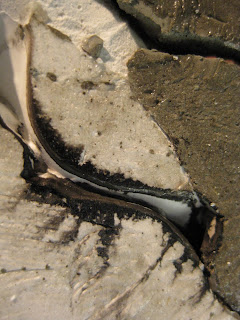Tuesday, March 30, 2010
Friday, March 26, 2010
Study 3: Shells 1st Attempt (K Malishewsky)
Thursday, March 25, 2010
Melissa Goldman_Test 5
So, I tried taking Peter's idea with the stretched nylon in a cage, but in the rotational molder to make hollow pieces. As per suggestion, I added "reinforcing" fiber to the rockite mix. That was a bad mistake. The fiber congealed all the concrete together in a ball rather than allowing for the mix to coat the inside of the nylon. Perhaps the nylon was also a bad surface to coat as it rotated and something like latex would be better.








Labels:
_melissa goldman,
concrete obsessions,
hollow,
nylon,
rotational molder
Tuesday, March 23, 2010
Monday, March 22, 2010
Saturday, March 6, 2010
Carent Faye & Debbie Lin - Test


 this test used "bags" of pantyhose stretched across the frame to dowels of varying heights (2, 4 and 6 inches) laid out in a grid. These were then stuffed with quickcrete mix and spread around within in the hope that the two pieces would be thin and capable of nesting together. The water to cement mix was 1:4. The concrete was very brittle on the piece that was stretched on the bottom so it subsequently broke apart into 3-4 pieces so no nesting of the pieces is possible. The surface textures are pretty rough but the pantyhose texture where visible is pretty interesting.
this test used "bags" of pantyhose stretched across the frame to dowels of varying heights (2, 4 and 6 inches) laid out in a grid. These were then stuffed with quickcrete mix and spread around within in the hope that the two pieces would be thin and capable of nesting together. The water to cement mix was 1:4. The concrete was very brittle on the piece that was stretched on the bottom so it subsequently broke apart into 3-4 pieces so no nesting of the pieces is possible. The surface textures are pretty rough but the pantyhose texture where visible is pretty interesting.
Friday, March 5, 2010
Thursday, March 4, 2010
Subscribe to:
Posts (Atom)











































